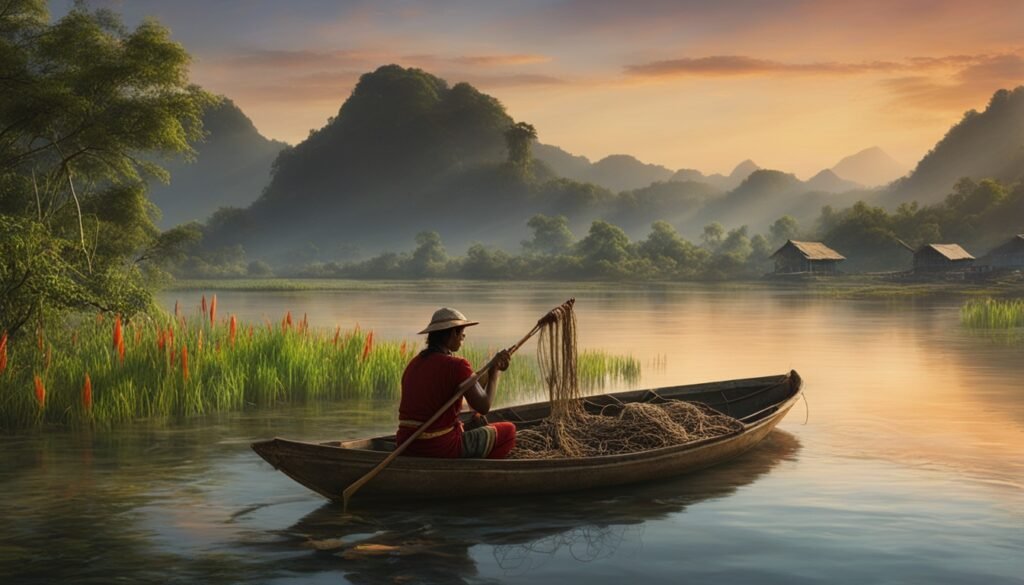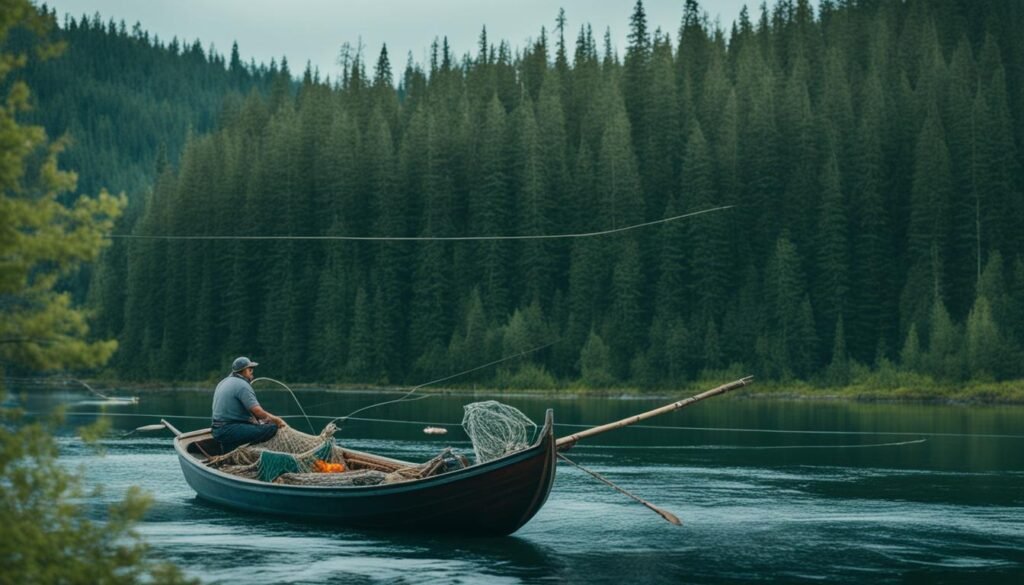Canada’s Indigenous fishing rights and regulations are complex and vital. These rights are crucial for First Nations’ cultures, economies, and identities. They go beyond just providing food for communities.
Indigenous fishing rights deeply affect how aquatic resources are harvested and managed. Many challenges arise as Indigenous communities assert their rightful claims.
Canada’s history shapes Indigenous fishing rights. Treaty agreements and Supreme Court decisions form the basis of these laws. First Nations have fought hard to protect their traditional ways of life.
The Robinson-Huron and Robinson-Superior Treaties of 1850 were early milestones. More recent rulings like Sparrow and Ahousaht have further defined these rights. These decisions continue to shape fishing practices in Canada today.
Key Takeaways about Indigenous Fishing Rights and Regulations
- Indigenous fishing rights are constitutionally protected as inherent and treaty rights in Canada.
- Historical treaties, such as the Robinson-Huron and Robinson-Superior Treaties, have enshrined Indigenous fishing rights in various regions.
- Supreme Court decisions, including the landmark Sparrow and Ahousaht rulings, have further defined and expanded the scope of these rights.
- The Aboriginal Fisheries Strategy (AFS) program provides funding and support for Indigenous fishing communities, creating jobs and facilitating sustainable management.
- Ongoing challenges, including industrial fishing, overfishing, and environmental degradation, continue to threaten the livelihoods and cultural practices of Indigenous Peoples in Canada.
Introduction to Indigenous Fishing Rights
Fishing has been vital to Indigenous communities in Canada for thousands of years. First Nations have used various tools to catch fish year-round. These include weirs, nets, traps, spears, and hooks.
This deep-rooted Indigenous fishing history is crucial to Aboriginal fishing practices. It’s also a key part of the cultural, social, and economic fabric of many Native food fishing communities.
Historical Overview of Fishing Practices
Coastal First Nations traditional fishing involved stone weirs, basket fish traps, and hand-held nets. These nets were woven from natural fibers. Today, nylon nets are the main choice for most Indigenous peoples.
Yet, these time-honored practices remain vital to the importance of fishing in Indigenous cultures.
Importance of Fishing in Indigenous Cultures
- Fishing is deeply embedded in the cultural, social, economic, and dietary practices of many Indigenous communities.
- The right to fish for food, social, and ceremonial (FSC) purposes is protected under Section 35 of the Canadian Constitution.
- May 21, 2018, was declared a National Day of First Nations Fishing Rights by the Assembly of First Nations National Fisheries Committee.
Indigenous fishing history shows the key role of First Nations traditional fishing. It highlights how Aboriginal fishing practices shape the lives of Native food fishing communities across Canada.
Affiliate Disclaimer: We may earn a commission from purchases made through the links on this page.
Treaties and Constitutional Recognition

Indigenous peoples’ rights in Canada have been recognized through historical treaties and the Canadian Constitution. The Numbered Treaties, signed from 1871 to 1921, confirmed Indigenous fishing rights on unoccupied Crown lands. The Douglas Treaties on Vancouver Island also recognized these rights.
These treaty rights are protected by Canada’s Constitution. They play a crucial role in preserving Indigenous cultures and economies.
Numbered Treaties and Fishing Rights
The Numbered Treaties cover much of Canada’s prairies and northern regions. They granted First Nations the right to fish on unoccupied Crown lands. This ensured access to traditional fishing grounds.
These rights have been vital to the relationship between the Crown and First Nations. They help sustain cultural and economic practices of Indigenous communities.
Douglas Treaties and Vancouver Island
The Douglas Treaties were signed with some Indigenous groups on Vancouver Island in the 1850s. They recognized the “right to carry on our fisheries as formerly.” This affirmed the nations’ ability to continue their traditional fishing activities.
Like the Numbered Treaties, the Douglas Treaties protect Indigenous fishing rights. They form part of Canada’s constitutional framework for these rights.
| Treaty | Year | Fishing Rights Recognized |
|---|---|---|
| Numbered Treaties | 1871-1921 | Fishing rights on unoccupied Crown lands |
| Douglas Treaties | 1850s | “Right to carry on our fisheries as formerly” |
These historical treaties have shaped the management of shared fisheries resources. They guide the ongoing relationship between the government and Indigenous peoples. The recognition of these rights helps preserve First Nations’ cultural and economic practices.
Supreme Court Decisions on Indigenous Fishing Rights
The Supreme Court of Canada has made key rulings on Indigenous fishing rights. These decisions protect First Nations’ rights to fish for various purposes. They include food, social, ceremonial, and sometimes commercial uses.
Sparrow, Gladstone, and Delgamuukw Cases
The R v Sparrow case in 1990 was a major shift. Ronald Sparrow, a Musqueam member, was arrested for breaking fishing license rules. The Court’s decision created the “Sparrow test” for Indigenous fishing rights.
The 1982 Constitution Act’s Section 35 strengthened these rights. Later, R v Gladstone (1996) and Delgamuukw v British Columbia (1997) expanded on Sparrow. These cases focused on commercial fishing and land title rights.
These rulings raised questions about community consultation and compensation. They set new standards for Indigenous rights in Canada.
Marshall and Ahousaht Decisions
The R v Marshall (1999) decision was also important. It confirmed rights promised in the Peace and Friendship Treaties. These included hunting, fishing, and gathering for Indigenous peoples.
In 2009, Ahousaht v Canada recognized more rights. It allowed the Ahousaht Nation to fish commercially in their traditional areas.
| Case | Year | Key Outcomes |
|---|---|---|
| R v Sparrow | 1990 | Established the “Sparrow test” for justifying infringement on Indigenous fishing rights |
| R v Gladstone | 1996 | Affirmed the commercial aspects of Indigenous fishing rights |
| Delgamuukw v British Columbia | 1997 | Recognized Indigenous land title and its implications for fishing rights |
| R v Marshall | 1999 | Affirmed hunting, fishing, and gathering rights promised in the Peace and Friendship Treaties |
| Ahousaht v Canada | 1999 | Recognized the Ahousaht Nation’s right to fish commercially within their traditional territories |
“The Supreme Court of Canada has issued several landmark decisions affirming Indigenous fishing rights, establishing that First Nations have constitutionally protected rights to fish for food, social, and ceremonial purposes, and in some cases, commercial purposes.”
Indigenous Fishing Rights and Regulations

Canada’s Department of Fisheries and Oceans (DFO) oversees fishing nationwide. They must respect Indigenous communities’ protected fishing rights. This includes allowing First Nations to fish differently for food and ceremonies.
The Peace and Friendship Treaties established Mi’kmaq fishing rights in 1760-1761. The Constitution Act, 1982 further affirmed these rights. In 1993, the Supreme Court of Canada ruled for Mi’kmaq leader Donald Marshall Jr.’s fishing rights.
Sipekne’katik First Nation started its moderate livelihood fishery in 2020. This caused conflicts with non-Indigenous fishers. Their claim is based on international laws like UNDRIP and ILO Convention No. 169.
| Indigenous Fishing Regulations | First Nations Fishing Permits | Aboriginal Subsistence Fishing Rules |
|---|---|---|
| The Canadian government, through the Department of Fisheries and Oceans, regulates fishing activities across the country, but must account for and accommodate the constitutionally protected fishing rights of Indigenous communities. | First Nations are allowed to fish for food, social, and ceremonial purposes using different methods and timing compared to the general public. | Aboriginal subsistence fishing rules provide Indigenous communities with the right to fish for their own use, rather than for commercial purposes, without the need for a license or permit. |
Key court cases have shaped Indigenous fishing rights in Canada. These include Sparrow, Gladstone, Delgamuukw, Marshall, and Ahousaht. They protect Indigenous rights to fish for commercial and subsistence purposes.
The government can only limit these rights for real conservation reasons. These rulings have strengthened various Indigenous communities’ fishing rights.
“Indigenous harvesting practices have special status under Canadian law, and Indigenous peoples have conducted their traditional fisheries since time immemorial.”
Tensions between Indigenous and non-Indigenous fishers still occur, especially during salmon season. The Canadian government tries to recognize Indigenous fishing rights. They allow traditional fishing methods and give permits for food and ceremonies.
International Laws and Indigenous Fishing Rights
International agreements uphold Indigenous fishing rights alongside Canadian laws. Two key instruments are the United Nations Declaration on the Rights of Indigenous Peoples (UNDRIP) and the International Labour Organization’s (ILO) Convention No. 169.
UN Declaration on the Rights of Indigenous Peoples
The UNDRIP, adopted in 2007, outlines Indigenous peoples’ rights worldwide. It recognizes their urgent need for respect and promotion of inherent rights.
UNDRIP affirms collective rights as essential for Indigenous communities’ well-being and development. It emphasizes their right to lands, territories, and resources they’ve traditionally used.
The declaration highlights Indigenous participation in decision-making processes affecting their rights and livelihoods. This includes fishing and environmental conservation of their lands and resources.
ILO Convention No. 169
The ILO Convention No. 169 on Indigenous and Tribal Peoples is another key agreement. Adopted in 1989, it’s a legally binding instrument for Indigenous rights.
ILO Convention No. 169 affirms Indigenous peoples’ rights to natural resources on their lands. It emphasizes their participation in resource use, management, and conservation.
The convention stresses consulting Indigenous peoples and ensuring their informed consent on measures affecting them. Both UNDRIP and ILO 169 provide a framework for Indigenous fishing rights protection.
These instruments help Indigenous communities assert their rights and manage traditional fisheries sustainably. They’re important tools for UNDRIP Indigenous fishing rights, ILO 169 Indigenous fishing, and other international laws on Indigenous fishing.
Indigenous Governance and Fishing Laws

Many First Nations in Canada are enacting their own fisheries laws. This trend shows their growing self-governance over traditional fishing practices. Indigenous communities are taking control of their fishing resources.
First Nations Fisheries Laws
Several First Nations are managing their fisheries through self-determined laws. Sheshegwaning First Nation has created its own aquaculture law. Listuguj Mi’gmaq has established the first-ever salmon law.
The Nisga’a Lisims have developed fish and wildlife laws. These laws help them oversee their natural resources. These initiatives are crucial steps towards reclaiming ancestral rights.
First Nations are shaping the governance of their natural resources. Their laws align with cultural values and traditional knowledge. This approach ensures better stewardship of their lands and waters.
“The enactment of First Nations’ own fisheries laws demonstrates the growing trend of Indigenous self-governance and control over their traditional fishing practices and resources.”
Indigenous-led fisheries management is a big step in reconciliation. It acknowledges First Nations’ rights to manage their resources. This approach highlights the value of traditional knowledge.
Community-based methods for sustainable resource management are gaining importance. These practices ensure better protection of natural resources. They also promote cultural preservation and economic development.
Sustainable Fishing and Conservation
Indigenous communities in Canada have long practiced sustainable fishing approaches. They draw on Aboriginal traditional ecological knowledge passed down for generations. Many First Nations actively protect their fisheries’ long-term health through conservation and resource management.
Indigenous Approaches to Fisheries Management
Indigenous fishing methods like cast-net fishing and spearfishing have proven sustainable over time. These techniques allow for the release of non-targeted species. Rod-and-reel fishing also results in less bycatch.
The 2023 Expert Meeting report stresses the importance of Indigenous participation in Marine Protected Areas. This ensures conservation measures support traditional fishing practices. It also promotes the sustainability of Aboriginal traditional ecological knowledge-based fisheries management.
| Sustainable Fishing Practices | Benefits |
|---|---|
| Cast-net fishing | Allows for the release of non-targeted species |
| Spearfishing | Selective targeting of specific fish, minimizing bycatch |
| Rod-and-reel fishing | Immediate release of unintended catches, reducing bycatch |
The report calls for strategic advocacy to advance Indigenous Peoples’ rights in fisheries. It recommends sustained support for training and capacity-building. This helps preserve Aboriginal traditional ecological knowledge in First Nations fisheries conservation.
“Cooperation at all levels of government, from local communities to nations globally, is essential for effective fisheries management.”
Indigenous Fishing Rights and Reconciliation
Indigenous fishing rights in Canada are vital to reconciliation. Respecting these rights helps address colonial legacy. It ensures a fairer future for Canada’s fisheries.
Progress has been made in recognizing Aboriginal fishing rights. Three treaties in northeastern Ontario explicitly recognize these rights. The Morris-Olsen decision affirmed Indigenous people’s right to hunt at night.
The Sparrow decision in 1990 was a landmark ruling. It allowed government moratoriums on hunting and fishing. However, this power is rarely used due to conservation thresholds.
“The Fisheries Act states in section 2.3 that it upholds the rights of Indigenous peoples recognized in section 35 of the Constitution Act, 1982. Section 2.4 mandates that the Minister considers any adverse effects on the rights of Indigenous peoples when making decisions under the Act.”
The federal government has invested in moderate livelihood fisheries. About $535 million was spent between 2000 and 2018. The Marshall Response Initiative provided resources for Indigenous participation in commercial fishing.
Challenges remain in upholding Indigenous fishing rights. The Truth and Reconciliation Commission highlighted the need for change. It called for recognition of Indigenous laws and protocols in fisheries management.
Ongoing collaboration is crucial for protecting Indigenous fishing rights. The government, non-Indigenous Canadians, and First Nations must work together. This will create a more sustainable and inclusive future for Canada’s fisheries.
Challenges and Ongoing Disputes
Indigenous fishing rights face ongoing challenges and disputes. The conflict between Mi’kmaq in Nova Scotia and non-Indigenous commercial fishers is a prime example. This dispute shows the need for reconciliation and respect for First Nations’ fishing rights.
The Mi’kmaq fishing dispute in Nova Scotia has been a long-standing issue. In 2020, the Supreme Court affirmed the Mi’kmaq’s right to fish for a “moderate livelihood”. However, some non-Indigenous fishers have resisted this ruling, leading to ongoing conflicts.
Tensions have escalated at times. Over 350 Mi’kmaq lobster traps were removed from St. Marys Bay. A van storing Mi’kmaw catches was set on fire. These incidents show the need for better communication and understanding.
The dispute reflects broader challenges to Indigenous fishing rights across Canada. It highlights the importance of reconciliation efforts. Implementing UNDRIP and respecting treaty rights are crucial steps forward.
“The Mi’kmaq fishing dispute in Nova Scotia highlights the ongoing challenges and the need for further reconciliation, the implementation of international laws like UNDRIP, and the respect for the inherent and treaty-protected fishing rights of First Nations in Canada.”
For an overview of fishing regulations and licenses in Canada, please check this guide
Conclusion
Indigenous fishing rights in Canada are deeply rooted in history, law, and culture. The Sparrow decision marked a turning point in recognizing these rights. International frameworks have also acknowledged the importance of Indigenous fishing practices.
Challenges persist, as seen in the Mi’kmaq ‘Lobster War’ in Nova Scotia. More work is needed for reconciliation and self-governance. Sustainable fisheries management is crucial for upholding First Nations’ traditional ways of life.
The legal landscape for Indigenous fishing rights is complex and ever-changing. Balancing conservation, resource allocation, and Indigenous rights remains an ongoing process. Protecting these rights is vital for creating a fair future for all Canadians.
FAQ about Indigenous Fishing Rights and Regulations
What is the historical context of Indigenous fishing rights in Canada?
Fishing has been vital for Indigenous communities in Canada for centuries. First Nations use various tools to harvest fish year-round. Fishing is deeply rooted in Indigenous cultural, social, economic, and dietary practices.
How are Indigenous fishing rights recognized in treaties and the Constitution?
The Numbered Treaties confirmed Indigenous fishing rights on unoccupied Crown lands. The Douglas Treaties recognized the “right to carry on our fisheries as formerly.” These treaty rights are protected by Canada’s Constitution.
What are some key Supreme Court decisions that have affirmed Indigenous fishing rights?
Several landmark Supreme Court decisions have affirmed Indigenous fishing rights. These include Sparrow (1990), Gladstone (1996), Delgamuukw (1997), Marshall (1999), and Ahousaht (2009).
These cases established First Nations’ rights to fish for food, social, and ceremonial purposes. Some cases also recognized commercial fishing rights.
How do the Department of Fisheries and Oceans regulations accommodate Indigenous fishing rights?
The Department of Fisheries and Oceans regulates fishing activities across Canada. These regulations must account for Indigenous communities’ protected fishing rights. First Nations can fish for food, social, and ceremonial purposes using different methods.
What international laws and agreements recognize and affirm Indigenous fishing rights?
International agreements like UNDRIP and ILO Convention No. 169 recognize Indigenous fishing rights. These instruments protect Indigenous communities’ self-determination in managing their traditional fisheries.
How are some First Nations exercising their inherent fishing rights?
Some First Nations are enacting their own fisheries laws and regulations. Examples include Sheshegwaning First Nation’s aquaculture law and Listuguj Mi’gmaq’s salmon law.
The Nisga’a Lisims fish and wildlife laws also show Indigenous self-governance over fishing practices.
How do Indigenous communities practice sustainable fishing and fisheries management?
Indigenous communities use sustainable fishing approaches based on traditional ecological knowledge. Many First Nations actively participate in conservation efforts and resource management. They work to protect the environment and ensure long-term fisheries health.
How are Indigenous fishing rights related to reconciliation in Canada?
Recognizing Indigenous fishing rights is part of Canada’s reconciliation process. Respecting these rights helps address the colonial legacy. It promotes a more equitable future for Canada’s fisheries.
What are some of the ongoing challenges and disputes related to Indigenous fishing rights?
Challenges persist despite legal recognition of Indigenous fishing rights. The Mi’kmaq community in Nova Scotia faces conflicts with non-Indigenous commercial fishers. This highlights the need for further reconciliation and respect for First Nations’ fishing rights.
Source Links
- https://cbc.ca/news/canada/sudbury/hunters-and-gatherers-indigenous-hunting-fishing-rights-explained-1.4347488
- https://www.dfo-mpo.gc.ca/fisheries-peches/aboriginal-autochtones/afs-srapa-eng.html
- https://www.iwgia.org/es/documents-and-publications/documents/732-danish-institute-for-human-rights-iwgia-indigenous-peoples’-customary-fishing-rights-key-issues-and-input-from-the-expert-meeting-on-indigenous-peoples-and-fisheries-2023-en/file.html
- https://afn.ca/all-news/news/first-nations-fishing-rights-fact-sheet/
- https://www.dfo-mpo.gc.ca/fisheries-peches/aboriginal-autochtones/fsc-asr-eng.html
- https://aiatsis.gov.au/brief-introduction-indigenous-fishing
- https://dfo-mpo.gc.ca/fisheries-peches/aboriginal-autochtones/moderate-livelihood-subsistance-convenable-eng.html
- https://lop.parl.ca/sites/PublicWebsite/default/en_CA/ResearchPublications/201840E
- https://www.rcaanc-cirnac.gc.ca/eng/1100100028574/1529354437231
- https://indigenousfoundations.arts.ubc.ca/sparrow_case/
- https://www.lib.sfu.ca/help/research-assistance/subject/criminology/legal-information/indigenous-scc-cases
- https://dfo-mpo.gc.ca/fisheries-peches/aboriginal-autochtones/moderate-livelihood-subsistance-convenable/marshall-overview-apercu-eng.html
- https://ihrp.law.utoronto.ca/indigenous-fishing-rights-and-international-human-rights-law
- https://hakaimagazine.com/news/the-long-expensive-fight-for-first-nations-fishing-rights/
- https://indigenousfoundations.arts.ubc.ca/aboriginal_fisheries_in_british_columbia/
- https://www.dfo-mpo.gc.ca/fisheries-peches/aboriginal-autochtones/moderate-livelihood-subsistance-convenable-eng.html
- https://www.justice.gc.ca/eng/declaration/about-apropos.html
- https://www.un.org/development/desa/indigenouspeoples/wp-content/uploads/sites/19/2018/11/UNDRIP_E_web.pdf
- https://www.fordhamilj.org/iljonline/the-status-of-indigenous-fishing-rights-in-canada
- https://yellowheadinstitute.org/2019/03/25/reviewing-the-fisheries-act/
- https://laws-lois.justice.gc.ca/eng/acts/f-14/page-1.html
- https://www.humanrights.dk/publications/indigenous-peoples-customary-fishing-rights-key-issues-entry-points-advocacy
- https://education.nationalgeographic.org/resource/sustainable-fishing/
- https://www.cbc.ca/news/canada/sudbury/hunters-and-gatherers-indigenous-hunting-fishing-rights-explained-1.4347488
- https://www.ourcommons.ca/DocumentViewer/en/44-1/FOPO/related-document/11570511
- https://policyoptions.irpp.org/magazines/october-2020/first-nations-have-their-own-legal-authority-to-regulate-their-fishing-rights/
- https://www.mcinnescooper.com/publications/the-indigenous-right-to-a-moderate-livelihood-a-need-for-clarity/
- https://publications.gc.ca/Collection-R/LoPBdP/BP/bp428-e.htm
- https://thefishsite.com/articles/indigenous-fishing-rights
- https://borgenproject.org/indigenous-fishing-rights-in-canada/

